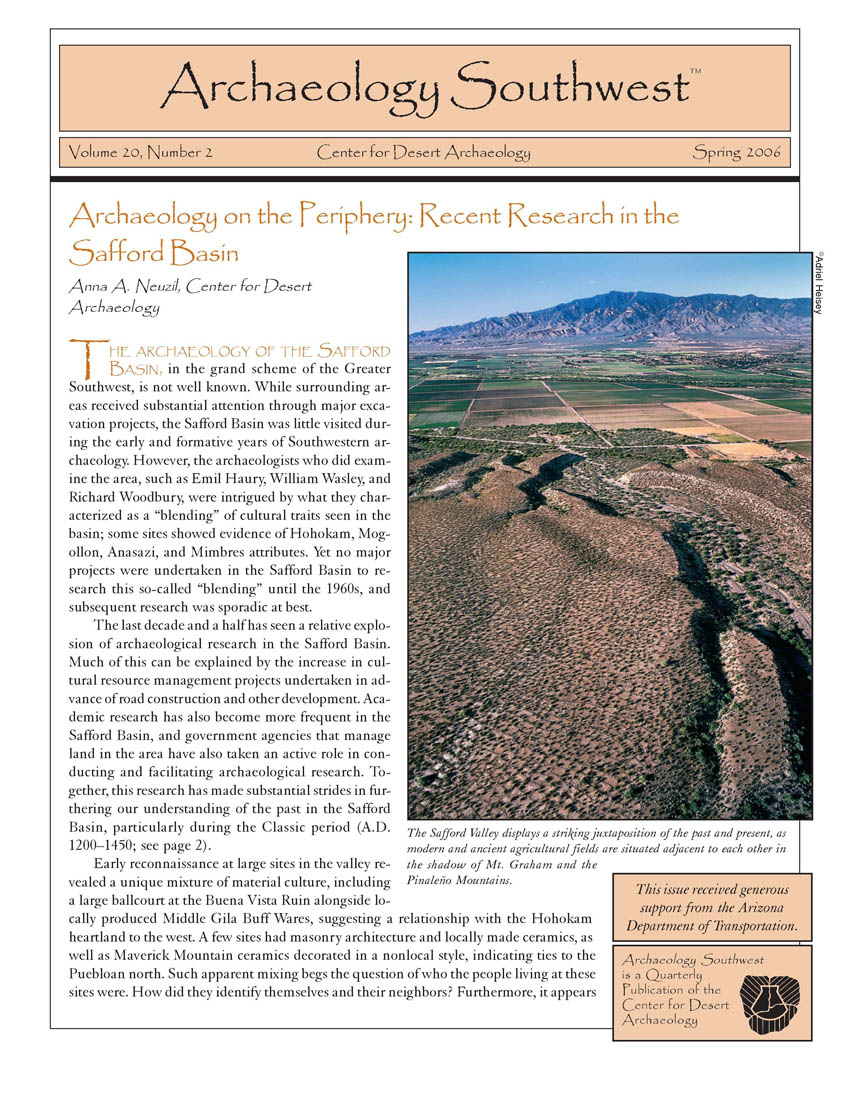Archaeology on the Periphery: Recent Research in the Safford Basin

The Safford Valley displays a striking juxtaposition of the past and the present, as modern and ancient agricultural fields are situated adjacent to each other in the shadow of Mt. Graham and the Pinaleno Mountains. Image copyright Adriel Heisey.
Archaeology Southwest Magazine Vol. 20, No. 2
FREE PDF DOWNLOAD
Issue editor: Anna A. Neuzil, Archaeology Southwest (formerly the Center for Desert Archaeology)
The archaeology of the Safford Basin, in the grand scheme of the Greater Southwest, is not well known. While surrounding areas received substantial attention through major excavation projects, the Safford Basin was little visited during the early and formative years of Southwestern archaeology. However, the archaeologists who did examine the area, such as Emil Haury, William Wasley, and Richard Woodbury, were intrigued by what they characterized as a “blending” of cultural traits seen in the basin; some sites showed evidence of Hohokam, Mogollon, Anasazi, and Mimbres attributes. Yet no major projects were undertaken in the Safford Basin to research this so-called “blending” until the 1960s, and subsequent research was sporadic at best.
The last decade and a half has seen a relative explosion of archaeological research in the Safford Basin. Much of this can be explained by the increase in cultural resource management projects undertaken in advance of road construction and other development. Academic research has also become more frequent in the Safford Basin, and government agencies that manage land in the area have also taken an active role in conducting and facilitating archaeological research. Together, this research has made substantial strides in furthering our understanding of the past in the Safford Basin, particularly during the Classic period (A.D. 1200–1450).
Early reconnaissance at large sites in the valley revealed a unique mixture of material culture, including a large ballcourt at the Buena Vista Ruin alongside locally produced Middle Gila Buff Wares, suggesting a relationship with the Hohokam heartland to the west. A few sites had masonry architecture and locally made ceramics, as well as Maverick Mountain ceramics decorated in a nonlocal style, indicating ties to the Puebloan north. Such apparent mixing begs the question of who the people living at these sites were. How did they identify themselves and their neighbors? Furthermore, it appears the archaeological labels of Hohokam, Mogollon, and Anasazi used in this area do not even begin to characterize the variability in material culture and variety of people seen in the archaeological record of the Safford Basin. As the articles in this issue of Archaeology Southwest demonstrate, much of the recent research in the area has been geared toward answering these questions.
Articles include:
Archaeology on the Periphery: Recent Research in the Safford Basin — Anna A. Neuzil, Center for Desert Archaeology
Migration in the Safford Basin — Anna A. Neuzil, Center for Desert Archaeology
The Goat Hill Site and Ancestral Pueblo Migrations into the Safford Basin — Kyle Woodson, Gila River Indian Community and Arizona State University
Marijilda Site — Bill Gillespie and Mary Farrell, Coronado National Forest
Irrigation and Migration: Bits and Pieces of Safford Basin Archaeology — Jeffery J. Clark, Center for Desert Archaeology
Dry-farming and the Rock-bordered Grid Fields of the Safford Basin — James A. Neely and William E. Doolittle, University of Texas at Austin
Salado Archaeology in the “Area Between” — Steve Lekson, University of Colorado at Boulder
Historic Canals of the Safford Basin — Verna Rae Colvin and Patricia A. Cook, Desert Archaeology, Inc.
The Archaeology of the Gila Box Riparian National Conservation Area — Tobi Taylor, Center for Desert Archaeology
The San Simon Basin — Patricia A. Gilman, University of Oklahoma, Norman
Eden Phase Occupations at Two Mogollon Villages — David E. Purcell, Four Corners Research, Inc.
Epley’s Ruin — Annick Lascaux, Tierra Right of Way Services, Ltd., and Gary Huckleberry, Geoarchaeological Consultant
A History of the Mills Collection — Linda Blan, Mark Bryce, and Brent McEuen, Eastern Arizona College
Research on the Mills Collection — Patrick D. Lyons and Anna A. Neuzil, Center for Desert Archaeology
Rex Owns — Anna A. Neuzil, Center for Desert Archaeology
Betty Graham Lee (1920–2005) — Anna A. Neuzil, Center for Desert Archaeology
Back Sight — William H. Doelle, Center for Desert Archaeology
Subscribe

